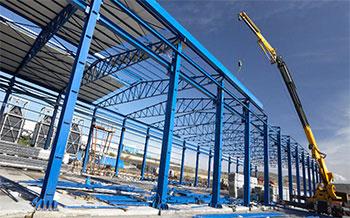
INDUSTRIAL STEEL BUILDING CONSTRUCTION

INDUSTRIAL STEEL BUILDING CONSTRUCTION
What Are Industrial Steel Buildings Utilized For?
An industrial steel building construction in Chennai is designed for safety and endurance so it can oblige the heavy industrial businesses that need a tough and economical solution for their business. One of the advantages of metal buildings is the more significant level of strength and stability they can give. There are many purposes that a industrial steel building contractors in Salem can offer, like superior plan adaptability and further developed usefulness. You can develop energy-effective, maintenance-free, and harmless to the ecosystem industrial buildings with steel.
Industrial warehouse steel building
An industrial warehouse steel building manufacturers in Theni is a sturdy construction designed for the management and storage of products, machinery, or production processes. Built mainly of steel, these buildings are strong, long-lasting, and reasonably priced. Steel is used to ensure structural integrity, which gives the warehouse long-term dependability and resistance to inclement weather.
Because of their adaptability, industrial warehouse steel building in Madurai can have large, open interiors that can accommodate a range of storage requirements. Furthermore, industrial steel buildings in Palani are adaptable, enabling adjustments to meet particular industry standards. Industrial warehouse steel buildings are a popular option for companies looking for effective and long-lasting storage solutions in today's cutthroat market because of their quick construction times and inexpensive maintenance costs.
Benefits of Industrial warehouse steel building
Due to their many benefits, industrial warehouse steel building in Cuddalore are a preferred option for companies looking for reliable and effective storage solutions. Their sturdy construction, which offers protection from inclement weather and structural integrity, is a major advantage. PEB Industrial Steel buildings in Pondicherry are renowned for their adaptability, which enables custom layouts to meet various storage requirements. Another benefit is the speed of construction; steel buildings can be put up quickly, saving businesses time and money.
Steel can be recycled and reused repeatedly without losing its quality, making it a sustainable and environmentally friendly material. Buildings made of steel are therefore ecologically friendly. Steel constructions also need less maintenance, which eventually results in cost savings. For industrial storage needs, steel's durability guarantees a long building lifespan and provides a dependable and affordable solution. To sum up, industrial warehouse steel buildings in Vellore are advantageous due to their long-term cost savings, sustainability, durability, and versatility. They also construct quickly.
Why Choose Industrial Steel Building Construction?
Industrial steel building construction in Nellore has emerged as a preferred choice for businesses and industries worldwide. Industrial steel buildings constructions in Salem offer a multitude of advantages that make them a reliable and cost-effective solution for various industrial applications. In this essay, we will explore the reasons why choosing industrial steel building construction in Erode is a wise decision.
Durability and Strength:
One of the primary reasons to choose steel for industrial warehouse construction is its exceptional durability and strength. Steel is renowned for its robustness, withstanding harsh environmental conditions, including extreme temperatures, heavy snow loads, earthquakes, and strong winds. Unlike traditional building construction materials such as wood or concrete, steel does not rot, warp, or crack over time. This inherent strength ensures that industrial steel buildings have a longer lifespan and require minimal maintenance, making them a cost-effective choice in the long run.
Versatility in Design:
Industrial Steel building contractors in Dindigul offers unparalleled design versatility, allowing businesses to customize their industrial buildings in Chennai according to their specific requirements. Whether it's a warehouse, manufacturing facility, distribution center, or storage space, steel buildings in Palani can be tailored to accommodate various layouts and functions. The flexibility of steel allows for large, open spans, enabling businesses to maximize their usable floor space without the need for intrusive support columns. Additionally, Industrial steel building in Erode can be easily expanded or modified as the needs of the industry evolve, offering scalability and adaptability.
Speed of Construction:
Time is a critical factor in industrial construction in Chennai projects, and steel buildings excel in this aspect. Steel buildings are pre-engineered and fabricated off-site, resulting in faster construction timelines compared to traditional building methods. The components of steel buildings are precision-cut and ready to assemble, reducing the need for on-site fabrication and minimizing construction delays. Consequently, businesses can significantly reduce project timelines, allowing for quicker occupancy and earlier commencement of operations.
Cost-effectiveness:
Cost-effectiveness is a key consideration in any construction project, and steel buildings in Neyveli offer difference advantages in terms of affordability. The availability of pre-engineered components and the speed of construction translate into reduced labor costs and shorter construction schedules. Moreover, steel is a highly recyclable material, allowing for cost savings during the manufacturing process. Additionally, Industrial steel buildings in Madurai require minimal maintenance, eliminating the need for frequent repairs and reducing long-term expenses. Over the lifespan of the building, the durability, low maintenance, and adaptability of steel buildings make them a financially prudent choice.
Sustainable and Eco-friendly:
In an era of increasing environmental consciousness, steel buildings align with sustainable construction practices. Steel is a highly recyclable material, and most steel used in construction is made from recycled sources. Furthermore, steel buildings contractors in Nagapattinam can incorporate energy-efficient design features, such as insulation, solar panels, and natural lighting, reducing energy consumption and operational costs. The durability of industrial warehouse steel buildings in Trichy also reduces the demand for new construction materials and promotes resource conservation. Choosing steel for industrial construction in Thanjavur showcases a commitment to sustainability and environmental responsibility.
Industrial steel building construction in Thiruvar offers a range of compelling reasons for businesses to choose this versatile and efficient building solution. The durability, strength, design flexibility, speed of construction, cost-effectiveness, and sustainability of steel buildings make them a preferred choice for a variety of industrial applications. As industries continue to evolve and grow, steel buildings provide the reliability and adaptability needed to meet the dynamic demands of the modern business landscape.
Industrial Building Construction
Industrial building construction in Palani refers to the process of planning, designing, and constructing industrial structurefor manufacturing, production, storage, and distribution purposes. These projects often require specific knowledge of industrial processes, safety regulations, and building codes to ensure that the facility meets the needs of the client and complies with industry standards.
Industrial Steel Building
An industrial steel building in Sivakasi is a type of structure commonly used for industrial purposes that is constructed primarily using steel components. These buildings are known for their strength, durability, and versatility, making them popular choices for industrial applications where large open spaces and high ceilings are needed. Industrial steel structure in Chennai can be customized to accommodate different layouts, equipment, and machinery, making them ideal for a variety of industrial uses.
Industrial Building Companies
Industrial building companies in Chennai are construction professionals or companies that specialize in building industrial structure. These builders have experience in working on industrial projects, managing complex construction processes, and coordinating with clients, engineers, architects, and subcontractors to deliver industrial construction projects on time and within budget. Industrial builders in Madurai play a key role in helping industrial clients develop custom-built facilities that meet their operational needs and comply with industry regulations and standards.
Industrial Building Contractors
Industrial building contractors in Trichy play a pivotal role in shaping the infrastructure of our modern world. These professionals are responsible for constructing the vast and complex facilities that house manufacturing plants, warehouses, distribution centers, and other industrial facilities. Their work is essential for the growth and development of economies, as these buildings are the backbone of various industries, including manufacturing, logistics, and technology. In this essay, we will explore the significance of industrial building contractors in Thanjavur, their responsibilities, challenges they face, and the evolving trends in the industry.
The Significance of Industrial Building Contractors
Industrial building company contractors in Salem are integral to the development of a nation's infrastructure. They provide the physical structures that house the machinery, equipment, and personnel necessary for industrial production. These facilities are crucial for economic growth as they support various sectors, including automotive, aerospace, energy, and pharmaceuticals, to name a few.
Infrastructure Development: Industrial building contractors in Vellore contribute significantly to the development of critical infrastructure. Their work creates jobs, boosts local economies, and enhances a region's industrial capacity. The construction of manufacturing plants, warehouses, and distribution centers stimulates economic activity, attracting investments and generating revenue.
Technological Advancements: As technology continues to advance, so do the requirements for industrial facilities. Modern industrial buildings in Chennai are equipped with state-of-the-art automation, energy-efficient systems, and sustainable construction practices. Contractors are at the forefront of incorporating these technologies into their projects, ensuring that industrial facilities are equipped for the future.
Responsibilities of Industrial Building Contractors
The responsibilities of industrial building contractors in Salem are diverse and demanding. They must possess a wide range of skills and expertise to successfully complete industrial construction in Madurai projects. Some of their primary responsibilities include:
Project Management: Contractors oversee the entire construction process, from initial planning and design to procurement, construction, and project completion. They manage budgets, timelines, and resources to ensure projects are executed efficiently.
Safety Compliance: Safety is paramount in industrial construction in Madurai. Contractors are responsible for implementing safety protocols, training workers, and ensuring that construction sites adhere to strict safety regulations to prevent accidents and injuries.
Quality Control: Industrial facilities require high-quality construction to meet industry standards and regulations. Contractors are responsible for ensuring that all construction work meets these standards, and they often employ quality control measures and inspections to achieve this.
Collaboration: Contractors work closely with architects, engineers, subcontractors, and clients to bring industrial projects to fruition. Effective communication and collaboration are essential for project success.
Challenges Faced by Industrial Building Contractors
While industrial building contractors in Theni play a vital role in infrastructure development, they also face numerous challenges, including:
Cost Management: Industrial projects often involve substantial budgets, and cost overruns can be detrimental. Contractors must carefully manage costs to ensure projects remain financially viable.
Skilled Labor Shortages: Finding skilled laborers, including tradespeople and construction professionals, can be a challenge. The industry is facing shortages of skilled workers, which can lead to delays and increased labor costs.
Regulatory Compliance: Industrial construction in Sivakasi projects are subject to a myriad of regulations, including environmental, safety, and zoning laws. Contractors must navigate these complex regulatory landscapes to avoid delays and legal issues.
Sustainability Demands: There is a growing demand for sustainable and environmentally friendly construction practices. Contractors must adapt to these demands by incorporating green building techniques and materials into their projects.
Evolving Trends in Industrial Building
The industrial building construction in Palani is continuously evolving to meet the changing needs of the global economy. Some notable trends in the industry include:
Prefabrication and Modular Construction: To expedite project timelines and improve construction efficiency, contractors are increasingly using prefabricated and modular construction methods.
Automation and Robotics: Automation and robotics are being integrated into industrial construction to improve precision and efficiency. Robotic construction equipment and 3D printing are becoming more common.
Sustainable Practices: Sustainable construction practices, such as energy-efficient building designs and the use of renewable materials, are gaining prominence as businesses and governments focus on reducing their carbon footprints.
Digital Technology: Building Information Modeling (BIM) and other digital technologies are enhancing project planning, design, and management, leading to more streamlined and cost-effective construction processes.
Industrial building contractors in Erode are the unsung heroes behind the vast industrial infrastructure that powers our economies. Their role in planning, managing, and executing complex construction projects is instrumental in shaping the future of industries worldwide. As the industry faces challenges and embraces evolving trends, these professionals will continue to be at the forefront of innovation, ensuring that industrial facilities remain efficient, safe, and sustainable for generations to come.
Picking an industrial building contractor in Madurai is a basic part in any new construction project. Consider these three variables as you contrast contractors and get ready with send off a significant framework expansion. A specialty contractor, similar to our group at Industrial Construction Incorporated, smoothes out the construction cycle to limit free time and pointless spending.
Industrial shed building construction in Chennai of any sort can dismay, no doubt. In the event that you want to rejuvenate an industrial space of any sort, you probably have a ton of various forms of feedback about the general cycle. There are loads of interesting points like timetables, planning various schedules, and your general procedure for how you could get your industrial building finished. You will probably require all the help you with canning get with both building plan and execution.









